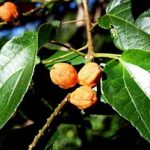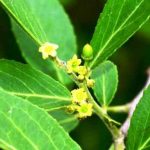TREE LIFE
August 1984
HARARE CALENDAR
Saturday August 4th: Botanic Garden Walk. Meet in the Car Park at 1045 for 1100 hours.
Monday August 6th at 1930 hours : Last month Phil promised you some news on my trip to the European Environmental Bureau’s conference on “Deforestation in Developing Countries” where I presented a talk as a representative of the Tree Society, being a non governmental organization. I also travelled to Devon and met the Chairman of “The Man of the Trees”, Mr. Dennis Hull. There is, in fact, so much to say and having returned to a full lecture program the report has only just begun. Instead this month we offer you the option of coming to the University on Monday, 6th August where I will tell you about my trip and answer the barrage of questions. The report can then be run off later and included in Tree Life. If you would like to bring some milk and eats along we will arrange the evening to include tea.
Directions : Enter the University from Churchill Avenue, take the first tarred road to the left then the first road right. The Zoology Department is now ahead of you on your right the car park is just to the left at the top of the road. I will try and find a few functional light bulbs for the occasion. Entrance free and all are welcome. If you cannot drive at night possibly you could phone Phil and he will see what can be arranged.
Sunday, August 19th : Bushman’s Point and Tree Society Arboretum, Lake McIlwaine. Our other plan for this month’s outing did not materialize so we have decided to do the long promised Arboretum visit this month. As this does not fill a whole day we decided to go there in the afternoon and combine it with a visit to Bushman’s Point in the Game Park for the morning. The Arboretum was one of the early projects of the Society and involved planting of trees, both exotic and indigenous, together with protection of existing trees and natural regeneration, on a site near the dam wall on the South Bank. During the war years especially little attention was paid to the Arboretum and since then our attention has been focused elsewhere, so I think this will be an interesting visit for a variety of reasons. The area around Bushman’s Point is the one place in the Game Park where one is not confined to one’s car. A good variety of trees is to be seen there, many of the trees have been labeled. The possibility of seeing some game going to and fro is an added bonus. A bird watchers haven as well, of course! No bus has been booked, as the quote supplied was quite high. However, we will still meet in the Car Park where a security guard will be on hand to keep an eye on vehicles left behind. As we have done a few times this year, we will share transport. Those who can offer seats are earnestly requested to come to the meeting place as we are loath to leave anyone behind for lack of space. Meet at 0845 for departure at 0900 hours. Please note that there is a nominal entry fee to the Game Park of 50c per person.
MATABELELAND BRANCH
Sunday August 5th : Again the Matopos. This time we will do the first part of the Arboretum Walk The path is flat for quite a distance and runs between Maleme Dam (or what used to be the dam) and the granite ridge. Meet at 6 Caithnes Road at 0830 hours and, depending on whether you want to stay out for the day, bring lunch.
Sunday July 1st : We went to the Matopos, keeping to the Circular Drive and down to Maleme Dam. We made a note of all the Ficus we saw and listed Ficus sur, F. abutilifolia, F. ingens, F .glumosa, F. salicifolia and F. tettensis, the most numerous being F. sur. The only one we could have expected to find and did not was F. natalensis. We found a magnificent specimen of F. salicifolia which had spread by branches touching down and rooting. On the way down to Maleme we stopped to look at a Crossopteryx febrifuga, which is not common in the Matopos. We peeled off a small portion of the bark and saw the crystals which, we are told, are used in the treatment of fever.
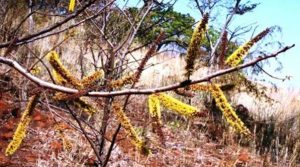
Elephantorrhiza goetzei. Photo: Mark Hyde. Source: Flora of Zimbabwe
We lunched on a favourite rock overlooking Maleme Dam (what remains of it), where grows Elephantorrhiza goetzei. Someone or something had been busy rootling among them and we wondered whether the roots were used for a human purpose or whether porcupine or bush pig were the culprits. We saw no droppings nor quills. Is there any information on this?
After lunch those of us who were making a day of it walked to the Arboretum walk, against the arrows, a most interesting and beautiful walk, and strongly recommended to any of you from Harare who might visit this area. We found a Pittosporum viridiflorum with its finely spotted bark and horizontal markings, and a Hexalobus monopetalus on which we noted the spherical growths on the stems. We think they could have been the petioles of the leaves which have dropped, but would like some information please!
BOTANIC GARDEN WALK, SATURDAY 7TH JULY
Having looked at some of the constituents of the Low Altitude Rain Forest on our June walk in the Gardens we decided to further investigate this ecological niche on our July walk. The general localities where this ecology is found was described last month by Gill Masterson in her write up of the walk.
Last month we saw that very rare member of the VIOLACEAE, namely Rinorea ilicifolia. There are in fact four species of this genus all within the same forest. Apart from R. ilicifolia we saw R. gazensis, also called R. fernigirea, a slow growing under storey tree or bush, usually around 2 m in height which gets a pretty pale yellow flower. The leaf on this gets a slender drip tip. Although all the Rinoreas have strongly serrated leaf margins, those of R. convallarioides are less prominent than those of the others. Again, this is a constituent of the under storey particularly on the higher banks along the rivers. Its flowers are greenish white to cream. Those of R. arborsa are also a cream colour. This latter tree was only recently identified in Zimbabwe but is fairly abundant on areas of dolerite.
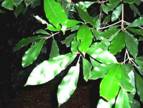
Mascarenhasia arborescens. Photo: Bart Wursten. Source: Flora of Zimbabwe
Having studied the family last year some of us were able to identify, to genus, Tabernaemontanum ventricosum of the family APOCYANACEAE, having opposite leaves and paired round fruits and a milky sap. With this we were later able to compare Mascarenhasia arborescens, also APOCYANACEAE, and also bearing paired fruit, but this time larger and more slender horn like fruit. The tree grows to 15 m and occurs along the rivers.
Another tree we managed to guess was Bequaertiodendron natalenses of the SAPOTACEAE, family, a smallish tree of the rain forest with noticeable drip tips, the function of which is thought to be to shed water quickly to assist in the collection of light, in a community which competes for this commodity. This tree demonstrated the SAPOTACEAE characters of alternate leaves, the leaves at the growing point tending to be folded back and the branchlets describing a looping wave pattern as they grow out laterally. These points and also the silvery brown growing point were also observed on B. magalismontanum which ubiquitously occurs not only in these forests but also along our dry land rivers and on the bleak slopes of Magaliesberg itself in the Transvaal, and ranging from a 35 m giant to a meter high shrub. The common name “stem fruit” arises from the fact that the flowers grow from the main branches and stems, a phenomenon known a ‘caulliflorae’. This was evident on another of the SAPOTACEAE, namely Pachystella brevipes, a medium to large sized tree, common in the Haroni-Rusiu forest and bearing tasty edible fruit.
Dracaena reflexa of the monocotyledons is a member of the under storey in these forests. Also of the monocote was the palm Phoenix reclinata and though not strictly within our political boundaries, Pandanus livingstonionus.
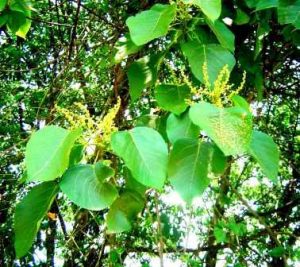
Macaranga capensis. Photo: Bart Wursten. Source: Flora of Zimbabwe
Another tree not quite, politically, ‘ours’, yet, but occurring nearby on the Mt. Zembe was Caracoa oursa, of the family EUPHORBIACEAE, a canopy tree of the evergreen forest. Also of the EUPHORBIACEAE, was a tree which Tom Muller said reminded him of Paris. This was Cleistanthus apetalum another riverine tree of the low altitude forest with alternately arranged, smallish leaves again with a drip tip. The Paris connection arises from the fact that a bark slash reveals a bright red colour, just like the latest lip sticks from the Paris fashion houses. Beneath this is the contrasting white of the xylem. The tree in the garden was unfortunately too young in fact to demonstrate this seductive property.
Also in the EUPHORBIACEAE was Macaranga capensis, a rain forest pioneer which has big stipules characteristic of the family, although in other members the stipules fall early. It has a peltate leaf. This means that the petiole joins the leaf within the leaf margin and does not join at the edge of the leaf. The Macaranga also has spiny outgrowths from the trunk. It is a genus which demonstrates continental drift being found on the far-flung particles of the old super continent of Gandwanaland, one species being found as far off as Taiwan!
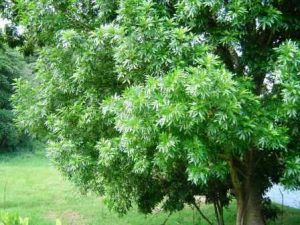
Filicium decipiens. Photo: Bart Wursten. Source: Flora of Zimbabwe
Allophylus chaunostachys is a shrub of the rain forest. Although appearing quite different from A. africana which we are used to from the Highveld kopjes and termitaria, it was still trifoliate and according to Trees of Southern Africa also has the pockets of minute hairs in the axils of the veins on the underside of the leaf. This belongs to the family SAPINDACEAE of which we also saw Filicium decipiens. We had seen this before when we looked at the family and so due to the amazing large winged rachis, we actually recognized it.
We looked at a few members of the family RUBIACEAE which occur in these low forests, starting with Breonadia microcephala, which more than superficially resembles Rauvolfia caffra of the family APOCYANACEAE. The timber of this big tree was once extensively used for railway sleepers. It is somewhat difficult to see the interpetiolar stipules which are characteristic of the family as the leaves appear in tight terminal clusters. Thereafter we saw the extremely rare Gardenia imperialis of which only one specimen was ever found in the Burma valley in 1969. Cremasporum caffrum is a common shrub occurring along the streams with a thread-like stipule between the opposite leaves. Another member of the family which becomes dominant in the sub canopy is Aidia micrantha. This is, once again, a drip-tip tree.
Turning to MIMOSACEAE, we looked at Entada pursaetha a liane/tree which produced a large pod which can be 1.5 to 2 m long breaking up into a characteristic fashion. These pods are carried down to the sea and are a familiar sight washed up on the Beira beaches. The common name is, predictably, the sea-pod. Albizia glaberrima is also of this family. Whilst it can be found in these forests it can also be seen on the banks of the Sabi.
Another under-storey tree we looked at was Vitex doniana. This has the same digitate leaf arrangement we are used to seeing on Vitex payos in the Highveld woodlands. However, with no need for drought resistance, being in the rain forest it has a very smooth leaf, unlike that of V. payos.
We then took a look at the unnamed Vapaca or “Vapaca sp. no. 1” very much a tree of the high rainfall, low altitude forest, where with its roots water logged in the streams it develops stilt roots. However, in the Gardens, in the absence of these conditions, it grows in the orthodox tree fashion.
Bridelia atroviridis is now a very rare tree of the low wet forest. When found it may be a shrub, or a tall tree, as high as 22 m. Once again being a denizen of the wet forest, it sports a drip tip on the leaf.
A huge tree of the rivers in the low altitude forests is Syzygium owariense. This will reach 40m. However, despite obvious morphological differences, the boffins in London have chosen to overlook its separate identity from S. quineense.
Our thanks go to Tom for this fascinating glimpse of the pukka jungle which most of us will probably never see in situ and if we do, we won’t have Tom to tell us what we are looking at.
-J.P.Haxen
THE MARIANGWE ROAD, HARARE SOUTH : 15TH JULY 1984
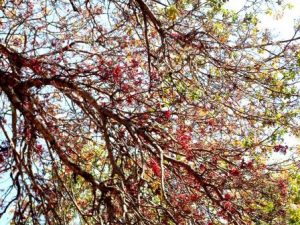
Schotia brachypetala. Photo: Penny English. Source: Flora of Zimbabwe
As we were early for our hosts we stopped to examine a patch of bush at the beginning of the Mariangwe Road. The first sight was a stately Schotia brachypetala on an ant hill. This is not unusual for Harare South where we usually see fine Schotia specimens on all the ant hills (remember the Conolly farm), but this one was in full flower. The red blooms produce so much nectar it rains down, resulting in the common name of weeping boerboom. I did not notice the rain but could not fail to see the numerous birds amongst the foliage, including a variety of sunbirds. The paripinnate leaf helped to place it firmly in the CAESALPINIACEAE.
We found our ‘friend’ Cassine once again. I never seem to remember that C. aethiopica has alternate or spirally arranged leaves whereas C. matabelica usually has opposite or sub-opposite leaves. This plant was C. aethiopica.
A new species for me was Ehretia amoena. Meg found this plant scrambling through other vegetation on an ant heap. Both surfaces of the diamond-shaped leaves were covered in short hairs which are characteristic of many species within its family, the BORAGINACEAE. This is generally a family of herbs, such as the forget-me-not, although there are a few shrubs and trees. One of the claims to fame of this family is that decoctions of one of the American BORAGINACEAE have a pronounced contraceptive action and their use by the Indians of western North America provided the inspiration for the development of commercial oral contraceptives.
Just as we were getting involved it was time to move on to Zengea, the farm of Wolle and Birthe Kirk. We were led into the bush by their daughter, the farm’s strong armed cattle rancher, Rille, riding her motorbike. The bush appeared dry but according to Wolle there is still sufficient grazing for the cattle. It may be worth mentioning that Wolle is well known for his successful importation of Red Dane Cattle from Denmark by a process known as embryo transplant – the living embryo are rapidly frozen in Denmark, flown out, and then transplanted, still alive, into a local cow where they complete gestation.
For most of our indigenous trees, Autumn simply means allowing their leaves to dry out and turn yellow. The soft green leaves of Spring are now hard and tough and lie scattered in the hot sand. Monotes glaber was one such notable tree, many displayed that distinctive orange-yellow foliage. But two species added colour to the local woodland, Pseudolachnostylis maprouneifolia looked spectacular in its red costume and maybe more of us could have removed our shoes in reverence to the burning bush effect created by Flacourtia indica, with its flame like leaves flickering in the breeze.
Down towards the river, a Ficus thonningii squatted on top of a 6 foot high rock looking just like an octopus with its roots hanging down on all sides. We often see the ‘dwarf’ Syzygium huillense in the vlei areas, but here the river had exposed the roots of one specimen displaying a fat limb. Was this in fact the often-mentioned underground trunk?
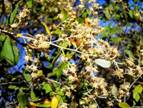
Tarchonanthus camphoratus. Photo: L.E.Lauritsen. Source: Flora of Zimbabwe
We stopped to examine a number of sizeable Tarchonanthus camphoratus on a termite mound. Here Brian Best broke the news that they may have male and female trees, and so they may (please note the lack of dogma – I am learning). According to Prof. Wild in Kirkia, this genus has “dioecious trees or shrubs”. Palmer and Pitman’s Trees of Southern Africa states “The flowers are borne in heads, the male in small greenish white balls, the female usually forming wide, many headed sprays at the ends of the branches. The tiny seed like fruits in the female inflorescence are enveloped in what appears to be cotton wool, completely lacking the bristly appearance of the Brachylaenas.” That was news to me.
Just to list some of the other highlights on Zengea, an old Pappea capensis, numerous large Ficus sur, Terminalia mollis in fruit, these fruit do not have the pink tinge which the other species have, the Swartzia madagascariensis looking like Medusae with all of their snake beans, Combretum zeyheri overcrowded with large yellow fruit and a Ficus verruculosa which had forgotten its lowly sprawling self and formed a number of four foot trunks. We must thank the Kirks for allowing us to invade their property and apologize to young Elsa for having distracted some of the family away from her ‘fodselsdag’ party.
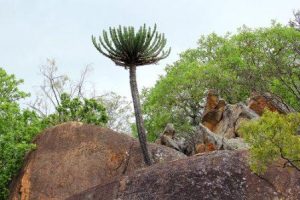
Euphorbia cooperi. Photo: Bart Wursten. Source: Flora of Zimbabwe
In the afternoon we headed yet further down the Marirangwe Road to the Dzumbumu Dam, a spot which Meg discovered some time back. Here was a kopje of large Euphorbia cooperi, and so close to Harare too. These succulents are reported to be most poisonous. This generally lowveld species differs from the E. ingens we usually see in that the segments of E. cooperi are more diamond shaped and the older branches are deciduous and fall, displaying the bare trunk studded with holes where the branches were.
We also saw a few tree-sized bushes of Osyris lanceolata, a plant I had called Colpoon for a long time. They both belong to the SANTALACEAE but whereas Colpoon has opposite leaves and is restricted to the coast, Osyris has alternate leaves and grows inland. The SANTALACEAE is generally a family of hemiparasites which are attached to the roots of other plants. I have no idea whether this also applies to these two genera. The sandalwood fragrance of soaps and cosmetics is distilled from a member of this family.
Other highlights of this site included numerous Rhoicissus revoilii, Zanha africana, a lone Kirkia on the dam spillway, a large Garcinia huillensis with yellow sap and a wealth of RUBIACEAE including Tarenna neurophylla, Pavetta schumanniana and numerous Catunaregam spinosa in fruit. A most rewarding trip indeed.
-Phil Haxen
ROOT NOTE : Recently we received a note from Mrs. Joan Higgs, the Secretary of the Tree Society of Southern Africa, in Johannesburg, who amongst other things says: We wondered if you would entertain publishing a note in your Bulletin to the effect that we would welcome any of your members to the outings of the Tree Society should they visit South Africa. The telephone numbers to contact are :
Mrs. Val Kleyn, our PRO, Johannesburg 782 5169
Mrs Joan Higgs, Hon. Secretary, between 0900 and 1700 hours on 642-4565 and after 1800 hours on 422-6559 – both Johannesburg
We would be very happy to meet your members when they visit our country.” We intend to extend a reciprocal invitation.
-P.Haxen
ROOT NOTE: It is strange how leaf arrangements always get split into opposite or alternate (or whorled), when in fact a lot of what is called alternate is really a spiral of leaves up the branch. If you remember all that stuff about Fibonacci, all of these spirals can be defined by the phyllotaxis, take a leaf, find the one directly above it, trace the spiral around until you come to this leaf, count the number of times you went around the stem and put that over the number of leaves in that set ( include only one of the end leaflets in that set, the other one would belong to the adjacent set). All of these numbers should fall in the Fibonacci series: 1;1;2;3;5;8;13;21…. Where each number is the sum of the two proceeding numbers. An opposite arrangement would be ½. If you visualize an upright twig at noon when the sun is directly overhead, each leaf will directly shade the second leaf below it. A rose usually has a 1/3 arrangement. This is more ideal as each leaf shade the third leaf below it. As one progresses along the series to 3/8, which is a common arrangement found in the bay leaf tree, avocado and yellow wood each leaf shades the eighth leaf below it. So as one progresses in the series the better the arrangement becomes to prevent mutual shading. Of course in nature branches are seldom upright and the sun is not vertical. In addition the light is not always direct but rather it becomes diffuse and is scattered. So the practical benefit of such an arrangement may not be all that significant. The ANNONACEAE for example, whereas others have a spiral, the CANELLACEAE. I mention this because the Canellaceae, which is represented by Warburgia salutaris, the cure all for all complaints which may no longer exist in the wild due to its famous medicine qualities, has now been removed from its position alongside the violet family VIOLACEAE and it is thought to fit more naturally with the magnolias alongside the ANNONACEAE, Conquist, 1981. I cannot question this move, but it is interesting to look at the vegetative features of these families. Although the books refer to them both as alternate, Warburgia has a spiral arrangement. (I noted a 2/5 phyllotaxis in the Botanic Gardens). This is not an obvious feature of the ANNONACEAE but it is interesting how often spirals turn up around the primitive magnolias. The bay leaf and avocado along with Ocotea and Cryptocarya are all in the LAURACEAE, a closely related family. I have not yet checked to see how consistent the spiral arrangement is within a species, could it possibly be used in a key?
-Kim ST.J.Damstra
-PHILIP HAXEN CHAIRMAN


